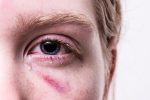
The teen years are known (at least in part) as a time of rebelliousness and risk-taking. This may be the result of brain development. Compared to adult brain activity, teenage brains show heightened sensitivity to rewards, and teens seem to be especially attuned to social reward cues from their peers. These neurodevelopmental differences are evident in both demographic and experimental research. For example, when peers are present, adolescent drivers are more likely to drive aggressively and be involved in accidents.
This peer effect extends to other contexts as well; compared to adults, peers are more likely to be present during teen criminal behavior or accidental deaths. This peer effect is a well-documented phenomenon; the goal of our study was to better understand why peers seem to motivate risk-taking behavior by studying teenagers’ brain activity and how other kinds of rewards might be used to mitigate risk-taking behavior in a peer context.
There were several clues in some recent insightful research studies that guided the development of our experiment. One was that the presence of peers seems to make teenagers more sensitive to rewards and more willing to take risks to get rewards. Another clue was that, in the absence of peers, rewards can be especially useful in getting teenagers to use their inhibitory control (the ability to stop and think before making a response).
The gap in research we aimed to fill was in considering how giving teenagers rewards for safe choices might protect against risk-taking behavior in a peer context. Our main idea was that peer observation should provide contextual motivation toward riskier decisions while monetary rewards favoring safe choices should provide the opposite motivation. We thought an experiment addressing this topic would be important because it could have implications for educational, prevention, or intervention programs aimed at effectively reducing adolescent risk-taking behavior that too often results in injury or death.
We recruited 24 normal adolescents for this experiment and brought them to our brain imaging research facility at Auburn University. The teens underwent brain imaging to measure changes in blood flow during a driving game where they had to decide whether to stop or go through a series of intersections under four different experimental conditions.
In one experimental condition, the adolescents were told that another teenager would be watching them play the driving game over the video camera in the brain scanner. In the second experimental condition, adolescents could earn money based on their choices in the driving game, which was rigged so that making safe choices to stop at intersections would earn more money than making risky choices to not stop at intersections. The third experimental condition was a combination of the first two; adolescents believed a peer was watching and they could earn more money by making safe (stop) choices at intersections. The fourth experimental condition was what is called a “control condition” where adolescents played the game without peer observation or monetary reward so that we had a baseline comparison. We were most interested in seeing how risky decisions and brain activity in the combined peer and reward condition was different from the other experimental conditions.
We found that teens made more risky choices in the control condition as compared to the peer and reward condition, but in contrast to expectations, teens did not make more risky decisions peer observation condition as compared to the peer and reward condition, though the trend was in the expected direction (we expected fewer risky choices in the peer and reward condition as compared to only peer observation; see Figure).

Figure courtesy Ben Hinnant.
In general, we also found greater blood flow in regions of the brain tied to limbic and cortical regions implicated in the integration of top-down cognitive and bottom-up emotional processes in the peer and reward conditions, as compared to the other experimental conditions during safe as compared to risky choices made at intersections. Specifically, we found consistent evidence for increased activity in the insula, a hub of cognitive-emotional transactions connecting prefrontal and reward regions, the posterior cingulate, which plays an evaluative role in processing cognitive-emotional motivations during inhibition and decision making involving reward, and parahippocampal gyrus, which likely contributes to memory encoding and retrieval for the experimental conditions.
To summarize, our results indicated that the key differences between the peer and reward condition and the other conditions were seen in cortico-limbic hubs that have been shown to play a role in regulating attention and integrating cognitive and emotional input and output. Our findings suggest that the defining characteristics of motivational conflict during safe, as compared to risky, decision making involve areas of the brain linked with attentional control and the integration of cognitive and emotional information, though there was some evidence for the involvement of more deliberative prefrontal areas as well.
Practically speaking, this may mean that introducing a reward that promotes safe choices may help adolescents to take just a little more time to process before enacting a decision when peers are present, though much of this motivational conflict processing seems to be happening at more automatic and “subsurface” levels of the brain. One possible example might be driver monitoring software that is sometimes used in driver education courses or offered by insurance companies; if safe driving choices were recorded and rewarded it could reduce risky driving behavior when teens are with their friends. However, further research is needed to shed light on decision-making in complex situations in order to best inform prevention programs aimed at reducing adolescent risk-taking behavior.









